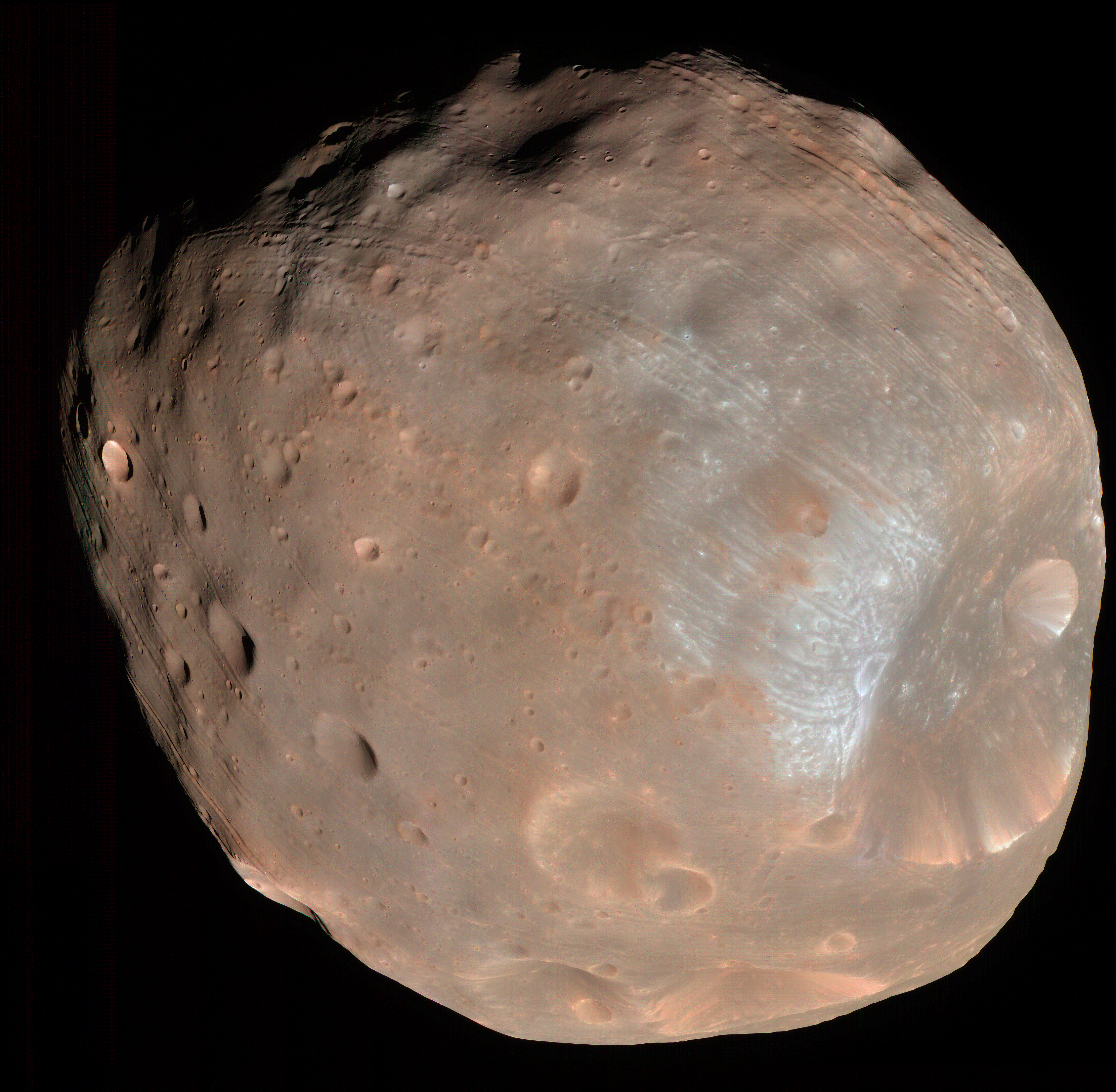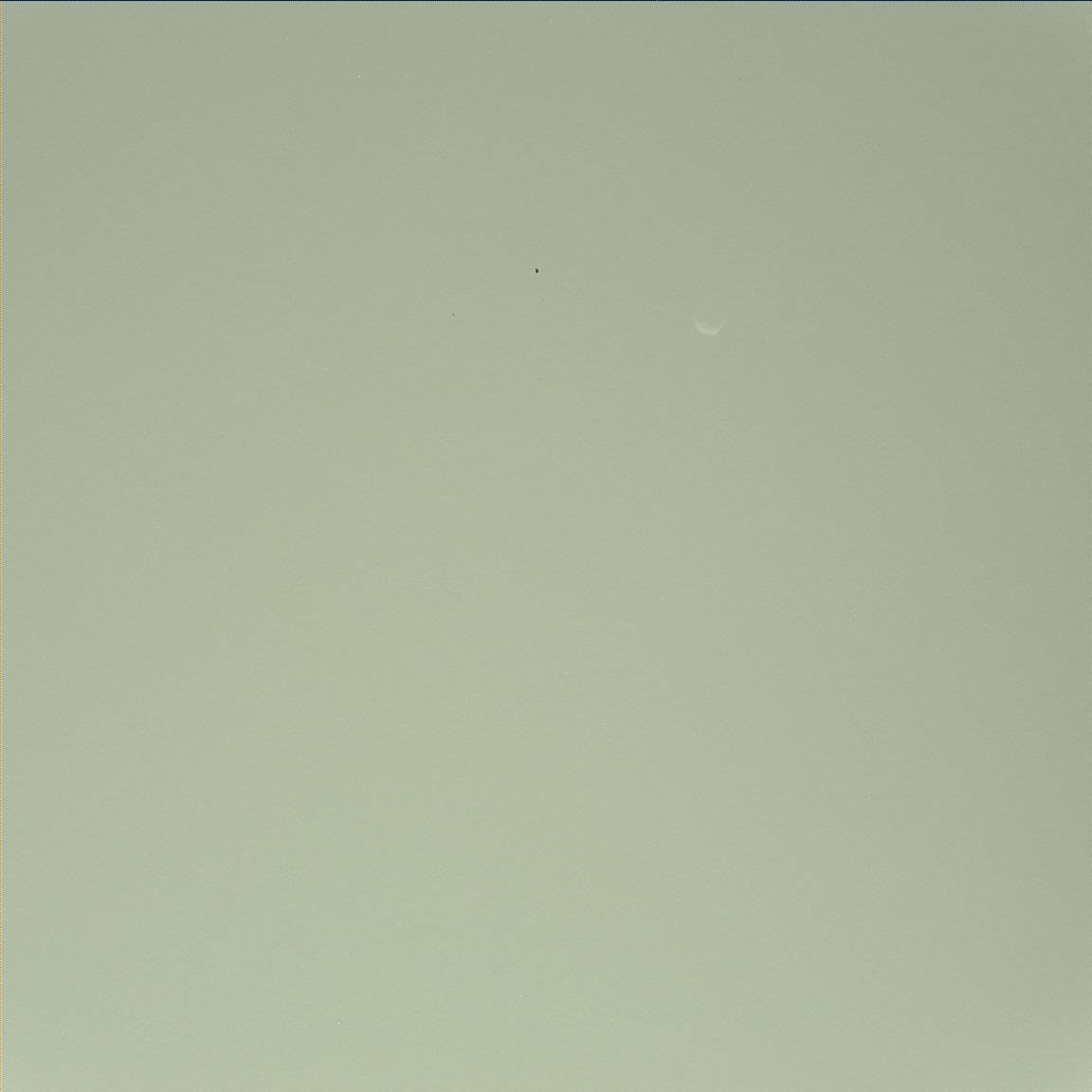Phobos: Facts About the Doomed Martian Moon

The Martian moon Phobos orbits only a few thousand miles above the Red Planet's surface. Its proximity to its planet is one of the reasons astronomers were unable to see the satellite until the late 19th century. In fact, the moon is getting closer to Mars over the centuries, and eventually will either break up or be pulled into the Martian surface.
Discovery and name
In the early 17th century, German astronomer Johannes Kepler proposed that Mars might host two moons, given that it lay between the Earth and Jupiter, which were known to have one and four satellites. No evidence of such moons could be found. Although most people thought that Mars had no moons, American astronomer Asaph Hall performed a methodical study from the U.S. Naval Observatory in Washington, D.C., searching closer to the planet than previous surveys.
After searching without success, a frustrated Hall was about to give up, but his wife, Angelina, urged him to continue. The next night, Aug. 12, 1877, he discovered the moon that would later be known as Deimos. Six days later, he found Phobos as well. The two moons lay so close to the planet that they were hidden by the glare of Mars. Asteroid-size, they are also two of the smallest moons in the solar system, with the larger Phobos 7.24 times as massive as its companion, Deimos.
In Greek mythology, Phobos was one of the sons of the god of war Ares (Mars to the Romans). The twin sons attended their father in battle. Phobos means fear (as in phobia), while Deimos means flight (especially in the sense of fleeing after a defeat), according to NASA.
Exploring the moons

As the exploration of continued, scientists were able to learn more information about the satellites circling Mars. The Viking orbiters flew by in the late 1970s. The Soviet Phobos 2 mission, NASA's Mars Global Surveyor, and the European Mars Express all provided more clues about the two curious moons. Rovers from the planet's surface even got in on the act, with Spirit, Opportunity, and Curiosity all providing images from the ground. NASA's MAVEN (Mars Atmosphere and Volatile Evolution mission) has also imaged the moon to try to learn more about Phobos' composition.
In 2011, Russia attempted to send a mission to the Martian moon called Phobos-Grunt, which was supposed to come back to Earth in 2014 bearing a small sample of the moon. The spacecraft, however, was marooned in Earth orbit due to issues with its rocket. Phobos-Grunt fell back to Earth in early 2012 and crashed into the Pacific Ocean.
NASA may not be finished with Phobos yet. The space agency is considering the Phobos Surveyor mission, which would deploy small, hedgehog-like probes to the surface of the moon. The mission is funded under NASA's Innovative Advanced Concepts program, which looks at concepts that could be decades away from flight.
In 2024, the Japan Aerospace Exploration Agency (JAXA) plans to launch the Mars Moons eXploration (MMX) mission to visit both Phobos and Deimos. MMX will land on the surface of Phobos and collect samples to be returned to Earth in 2029.
"Understanding how Phobos and Deimos formed has been a goal of the planetary science community for many years," David Lawrence, of the Applied Physics Laboratory, said in a statement. Lawrence leads the team to develop one of the instruments for MMX.
In 2016, a low-cost Mars orbiter mission called PADME (Phobos And Deimos and Mars Environment) was proposed to visit the moons. Among its major aims is to characterize where Deimos and Phobos came from — whether they were created at the same time as Mars, or captured from the asteroid belt, or somewhere else. PADME competed in NASA's Discovery Program but lost out to the Psyche and Lucy missions to visit asteroids.
Some human spaceflight proponents have also suggested NASA should land people on Phobos before Mars; NASA hopes to have a human mission sent there by the 2030s. But future explorers may be in for a shock. Powerful solar eruptions could charge regions of the Martian moon to hundreds of volts, potentially affecting electronic equipment.
"We found that astronauts or rovers could accumulate significant electric charges when traversing the night side of Phobos — the side facing Mars during the Martian day," William Farrell of NASA's Goddard Space Flight Center, Greenbelt, Maryland, said in a statement.
"While we don't expect these charges to be large enough to injure an astronaut, they are potentially large enough to affect sensitive equipment, so we would need to design spacesuits and equipment that minimizes any charging hazard."
Formation and composition
The examination of Phobos and its companion revealed more than their odd, non-spherical shapes. The two moons are dark gray in color, and heavily cratered. The moons are some of the darkest, least reflective objects in the solar system.
After observing the pair, scientists concluded that they were made of material similar to Type I or II carbonaceous chondrites, the material that makes up asteroids and dwarf planets. The composition and odd shape led some scientists to conclude that Phobos and Deimos came from the asteroid belt, with Jupiter's gravity long ago nudging them into orbit around Mars.
However, scientists aren't certain that the asteroid belt is the source of the moons' birth. Both have a nearly circular orbit unusual for captured objects. The thin atmosphere of Mars would have a hard time providing the necessary braking to settle the pair into their present-day orbits. Similarly, the moons are not as dense as objects in the asteroid belt.
Instead, the moons may have formed as satellites around Mars, with dust and rock drawn together by gravity.
A more violent birth may have occurred by collision. A large impactor smashing into the red planet could have sent pieces flying into the air, where gravity may have drawn them together. An existing moon might also have been destroyed, creating the rubble that later formed Phobos and Deimos.
A recent proposal combines the last two possibilities. According to researchers, a collision once scattered debris into a ring around Mars. As Phobos approaches the red planet, it will be torn into a ring again, scientists predict.
"Solving the riddle of how Mars' moons came to be will help us better understand how planets formed around our sun and, in turn, around other stars," Thomas Zurbuchen, associate administrator for NASA's Science Mission Directorate (SMD), said in a statement.
Traveling only 3,700 miles (6,000 kilometers) above the Martian surface, Phobos flies around the Red Planet three times a day. Crossing the sky in about four hours, the moon appears to rise in the west and set in the east.
Many science fiction films feature large moons dominating alien skies, but despite its proximity to its planet, Phobos is only a third as wide as the full moon seen from Earth. On the other hand, Mars dominates the horizon of Phobos, taking up a fourth of the sky.
Doomed
But Phobos won't zip around Mars forever. The doomed moon is spiraling inward at a rate of 1.8 centimeters (seven-tenths of an inch) per year, or 1.8 meters (about 6 feet) each century. Within 50 million years, the moon will either collide with its parent planet or be torn into rubble and scattered as a ring around Mars.
The unusual characteristics of Phobos, including its decaying orbit, led some scientists in the 1950s and 1960s to conclude that it was artificial. One prominent proponent was the science adviser to President Dwight D. Eisenhower. Further examination revealed that the moon bears stronger resemblance to a rubble pile than an artificial satellite, and images sent back from orbiting craft show that it formed in nature.
On the surface
The larger of the two moons, Phobos has a diameter of 10 by 14 by 11 miles (17 by 22 by 18 km). The surface is covered with a dusty powder 3 feet (1 meter) thick, likely caused by meteor bombardment.
A large impact crater dominates the moon. Stretching nearly 6 miles (9.5 km), Stickney Crater covers most of the surface. The impact that formed it likely caused many secondary impacts, as rocks flew up and fell back to Phobos. The crater bears the maiden name of Hall's encouraging wife.
The moon is marred by long grooves. In 2015, a NASA-led study suggested that the grooves on Phobos are actually early signs of the moon breaking apart due to tidal stresses induced by Mars' gravity.
"We think that Phobos has already started to fail, and the first sign of this failure is the production of these grooves," Terry Hurford, a research assistant at NASA's Goddard Space Flight Center in Maryland, who led a study about stretch marks, said in a statement.
Another theory stated that the grooves could be remnants of a huge impact that left behind the crater Stickney, but the grooves did not center on this crater. Another explanation is the moon's grooves could come from material displaced from Mars that hits Phobos' surface, which was espoused in an Open University study published in 2014.
Temperatures vary on Phobos, reaching highs of 25 degrees Fahrenheit (minus 4 degrees Celsius) during the day, while nights can be as cold as minus 170 degrees F (minus 112 degrees C).
The moon is so small that a 150-pound person standing on its surface would weigh only two ounces.
Facts about Phobos:
- Radius of moon: 6.9 miles (11.1 km)
- Semi-major axis around Mars (distance from planet's center): 5,826 miles (9,376 km)
- Closest approach: 5,738 miles (9,234 km)
- Farthest approach: 5,914 miles (9,518 km)
- Orbit eccentricity: 0.0151
- Orbit inclination: 1.075 degrees
- Time to make one orbit: 7.65 hours
- Mass: 1.0659 x 1016 kg
- Density: 1.872 g/cm3
- Surface gravity: 0.0057m/s2
- Escape velocity: 25 mph (41 km/h)
Follow Nola Taylor Redd at @NolaTRedd, Facebook, or Google+. Follow us at @Spacedotcom, Facebook or Google+.
Additional reporting by contributor Elizabeth Howell.
Join our Space Forums to keep talking space on the latest missions, night sky and more! And if you have a news tip, correction or comment, let us know at: community@space.com.
Get the Space.com Newsletter
Breaking space news, the latest updates on rocket launches, skywatching events and more!

Nola Taylor Tillman is a contributing writer for Space.com. She loves all things space and astronomy-related, and enjoys the opportunity to learn more. She has a Bachelor’s degree in English and Astrophysics from Agnes Scott college and served as an intern at Sky & Telescope magazine. In her free time, she homeschools her four children. Follow her on Twitter at @NolaTRedd










